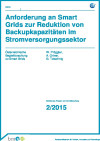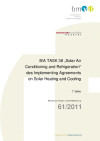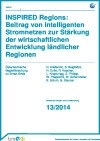Suchergebnisse für "Factsheet: Energietechnologien gestalten, die für alle sinnvoll und nutzbar sind"
Urban Mining - Energy and resource savings due to urban mining
The use of natural resources in long-lived products and buildings has led to the build-up of enormous urban material stocks. The present project analyses the potential of these urban mines to increase the resource efficiency of modern cities.
Sustainable construction of objects as a product service
Project of a Carinthian plant construction and manufacturing company. They plan to establish a new business division "sustainable construction of premises". This division shall offer a service package for housing, stores, and industrial production sites. This service shall be developed using the approach of RISP.
Participation in CEN TC 350 (sustainability of construction works) - WG4 Economic Performance Assessment of Buildings
Participation in the CEN TC 350/WG4 to develop a standard to evaluate the integrated effectiveness of buildings during their life cycle. Evaluation and integration of national comments in order to prepare the standard for the final vote.
Financing Models and Strategies for future Energy Infrastructures (FINAMO)
Contribution to decarbonisation 2050: The development of suitable financing models plays a key role when implementing new energy solutions. (Juli 2019)
S - House
Innovative Use of Renewable Resources demonstrated by means of an Office and Exhibition Building
Anforderung an Smart Grids zur Reduktion von Backupkapazitäten im Stromversorgungssektor

Österreichische Begleitforschung zu Smart Grids
Schriftenreihe
2/2015
W. Prüggler, A. Ortner, G. Totschnig
Herausgeber: BMVIT
Deutsch, 61 Seiten
Downloads zur Publikation
Aktuelle Ausschreibungen
REC-Businesspark - Investigation of the first Austrian renewable energy community business and industrial park
In the course of the project, the conceptual design of a zero-emission or plus-energy business park in Weiz with a focus on photovoltaics and fuel cells in combination with a Renewable Energy Community (E-EGe) had been carried out. By establishing the park on a "greenfield", all structures can be created according to the requirements of the E-EGe.
homeVALUE

The ecology and economy of housing. An assessment system for the evaluation of the suitability of buildings and housing estates for the future.
IEA SHC Task 66 Solar Energy Buildings - Industry Workshop
29. September 2022
Kassel, DE
Solar thermal and/or PVT combined with heat pump as a future CO2-neutral energy supply concept
IEA TASK 38 "Solar Air Conditioning and Refrigeration" des Implementing Agreements on Solar Heating and Cooling

Schriftenreihe
61/2011
T. Selke
Herausgeber: BMVIT
Deutsch, 294 Seiten
Downloads zur Publikation
IEA SHC Webinar on Renovating Historic Buildings Towards Zero Energy
28. January 2020, 12.00 - 13.30 GMT
Online
Real-world renovation experiences from the perspective of building owners, design teams and SHC Task 59 experts will be presented and discussed.
Journal paper by Austrian contributors of the IEA EBC Annex 66

The deployment-dependence of occupancy-related models in building performance simulation. (Energy and Buildings Volume 117, pages 313–320, April 2016)
A. Mahdavi, F. Tahmasebi
Herausgeber: Elsevier B.V.
Downloads zur Publikation
INSPIRED Regions: Beitrag von intelligenten Stromnetzen zur Stärkung der wirtschaftlichen Entwicklung ländlicher Regionen

Österreichische Begleitforschung zu Smart Grids
Schriftenreihe
13/2014
H. Aliefendic, S. Beiglböck
Herausgeber: BMVIT
Deutsch, 81 Seiten
Downloads zur Publikation
SmartQ+ Bruck/Leitha - Energy saving potentials through neighbourhood and community planning
First-time linking of transport and energy simulation models for municipal planning in order to visualise (energy) saving potentials in settlement development and effects of planning projects on mobility demand and the energy network of a municipality in an interactive visualisation.
MehrWertStrom 2030 - PV-Community system - Exploring a participatory pilot project with regional added value for structurally weak regions
The "MehrWertStrom 2030" project analysed the legal, technical, organizational and economic feasibility of PV community joint venture facilities on multi-party buildings including the added value for structurally weak regions and developed innovative solutions related to organization, financing and realization.
Spatial Energy Planning for Smart City Quarters and Smart Regions
In the project ERP_hoch3 energy related policy research in three Austrian agglomerations (Vienna – Lower Austria, Graz – Styria and Vorderland-Feldkirch) has been done, scenarios of the current state and the target state have been modelled and calculated. The aim was to develop generic transferable recommendations for spatial energy planning in agglomerations.
SchulRen+ Innovative plus-energy refurbishment concepts for school buildings
In a technical feasibility study and based on a real example, the project analysed innovative plus-energy refurbishment concepts for school buildings. The goal was to develop refurbishment concepts with a high replication potential which combine future-oriented energy concepts with feasible technical and architectural solutions.
SURO - The urban underground as mine? Potential of secondary resources in subsurface infrastructure systems
Feasibility of a resource cadaster to inventorize, characterize and locate material stocks in subsurface infrastructure networks. The results are used for the economic assessment of secondary resource potentials.
Development of low emission cleaning processes for metal surfaces considering manufacturing processes within the automotive industry
Development of technological optimisation of cleaning processes within the automotive industry which guarantee defined cleaning requirements and fulfil the criteria of a sustainable process design with near zero emissions.
